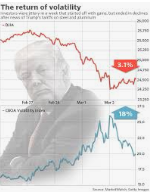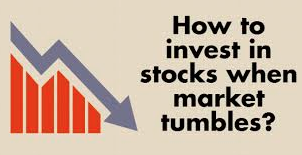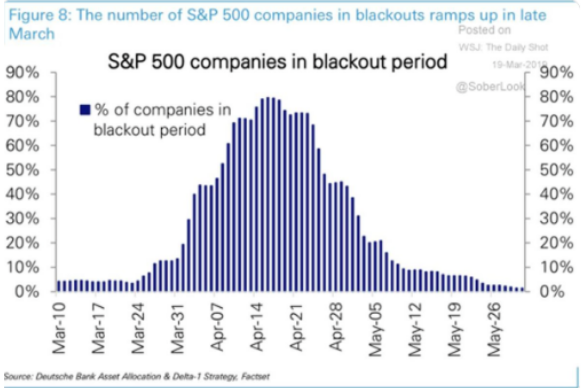Don’t look now, but last week the major indices hit repetitive all-time highs; yes again i.e. repetitive. “Oh it’s going to be one of those types of articles is it Seth”? No! In this article I’m going to do a little bit of recapping the week that was, projecting for the week at hand and entertaining for weak of spirit. “Weak of spirit”? Just go with me on this one.
The major averages were spurred to record levels after the Senate adopted a federal budget for next year, a key step on the road to tax cuts we are to presume or the market rally would have us believe. Some believe the budget bill’s passage, which allows the deficit to rise by $1.5 trillion over the next decade, will help goose the economy, leading to a selloff in Treasury bond prices and a rise in yields. While that may be the initial reaction to yields and as it was found to be last week, one should always recognize the long-term trajectory of bond yields. This trajectory finds itself, much like Volatility, seeking out new low yields over time.
The Dow Jones Industrial Average (DIA) advanced 164 points to 23326, and was up 2.0% for the week. The Nasdaq Composite Index (QQQ) gained 24 points at 6629. The S&P 500 (SPY) was up 13 points to 2575, and 0.9% for the week. Bank stocks were among the biggest beneficiaries of Friday’s market rally, with the Financial Select Sector SPDR (XLF) up 1.2 percent. The ETF has advanced 14.6% year to date. As it pertains to economic data, the calendar was light last week but found some better than expected housing data. In the latest economic data, existing home sales rose 0.7% in September, breaking a three-month losing streak and topping the consensus analyst forecast.
The rally in the broader index, the S&P 500, has been nothing short of spectacular and in some regards significantly unique. The benchmark hasn’t witnessed a single-session drop of 3% or greater in 241 days. This running streak, which is likely to continue this week matches the streak set from January 1995- January 1996. In truth a 3% single-session drop is a rare occurrence, but not experiencing one for this stretch of time is even more rare, which is why I have brought it to your attention. Nothing on the magnitude of natural disasters, geo-political turmoil, threats of military action (N. Korea) or even general market valuations have curbed investor appetite in quite some time. The bull market is some 9 years past the Financial Crisis and beyond the period for which many have called for a market top and subsequent market correction…and yet here we are trending ever higher.
The S&P 500 is on pace for its 9th consecutive year in the green, which would match the streak from 1991 to 1999 as indicated in the table below from Pension Partners Charlie Bilello:
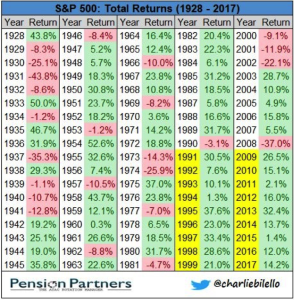
With the historic levels in market performance that find the S&P 500 up roughly 15% in 2017, the VIX has found a level of complacency not seen since the early 1990’s and for periods never have been expressed in the market since the onset of volatility tracking. These record low readings in the VIX were recently chronicled in my publication titled Earnings Season Kicks Into High Gear With Volatility At Record Low Levels. While many, including myself, are expecting to see volatility pick up in the coming days and weeks, that forecast or anticipation of greater volatility has been met with only a modest rise. In fact, the least volatile September ever recorded is now being followed by the least volatile October…thus far and as indicated in the table below form Charlie Bilello:

Investors and those participating in the VIX complex are best found appreciating low levels of volatility through the short-VOL trade and by utilizing VIX-leveraged ETPs. This trade has been highlighted, chronicled and scrutinized more frequently and with greater rhetoric throughout 2017 and as the VIX has maintained below its mean average reading in the mid-teens. I’m not a believer in VIX mean readings as it has largely been found that the VIX exists, over time, to express a desensitization of fear. In other words, the VIX is always on the hunt for new all-time lows and eventually that hunt will be rewarded as it has been in 2017.
The rhetoric surrounding the short-VOL trade continues to characterize the trade as being overcrowded. Recently, Twitter posts touted this through the more recent data that outlines new record level noncommercial net shorts in VIX Futures. But the data needs to be put into the most appropriate context for which Russell Rhodes has offered.
Non-Commercial net VIX futures position divides into VIX Futures Open Interest. Note things aren’t as dramatic when we look at this Non-Commercial short position in the context of the whole market. For the number centric readers, the Non-Commercial short positions in VIX futures was 25.8% of the open interest which in the case of a rise in VIX is probably a manageable number. (See Chart Below)
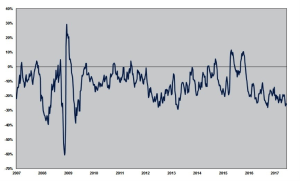
The analysis and review above from Russell Rhoads wasn’t what was promoted on Twitter however. What most people tweeted and responded to was the following chart:
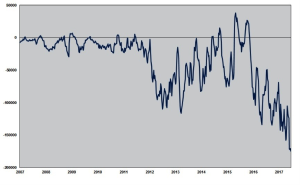
The net position for Non-Commercial VIX futures traders was -174,665, an all-time low. This figure has some VIX commentators noting a rise in VIX and VIX futures may cause some panicked buying or a short squeeze. However, looking at this figure in context of the whole market tells a different story.
It’s that picture, which isn’t positioned within the appropriate context, continuously finding detractors of the short-VOL trade on the wrong side of the trade or screaming, “the sky is falling”.
Having said that, investors should also recognize that the absence of volatility in the market place does not constitute the extinction of volatility. Much like uncanny weather or hurricanes, they may be absent for some time, but they always return to wreak havoc.
While the markets have maintained an appreciative performance throughout 2017 and over the past several years, this doesn’t necessarily equate to the average investor performing in kind with the markets. Unfortunately, as the longstanding Dalbar’s Quantitative Analysis of Investor Behavior study has found, most investors underperform the benchmark average annual rate of return. The table below was taken from Dalbar’s 2017 study and identifies this most factual representation of investor performance over decades and inclusive of 2017.
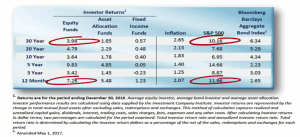
The single greatest impediment to investor success is, and likely will always be, psychological behavior of investors. Investors, according to Dalbar’s study, lack patience and execute investing strategies poorly across the psychological behaviors of fear aversion and herding. Dalbar’s Study identifies 9 behavioral biases that lead to poor investment decision-making as the largest contributor to underperformance over time. And the two main psychological behaviors driving investor underperformance are noted below:
- Loss aversion: The fear of loss leads to a withdrawal of capital at the worst possible time. Also known as “panic selling.”
- Herding: Following what everyone else is doing. Leads to “buy high/sell low.”
Dalbar’s Study has definitively defined that while the “buy and hold” strategy has been vastly promoted, it is impossibility when pinned against the natural human behavior and a failed philosophy amongst the investor community. Only those with deeply rooted investing disciplines have found such a philosophy of benefit. So while we presently review record levels in the market and a solid annual climb in the S&P 500, the vast majority of investors will have been found to underperform, as usual. Discipline is a key to long-term investing success. I often find myself pressured by the media and associates to look into XYZ strategy or XYZ stock as a means to invest, but often that advice fails to account for my base of knowledge surrounding that strategy or stock. That advice fails to account for my risk tolerance and discipline. I know what works for Seth Golden, what has worked for me over the last 18 years and through 3 market crashes.
This week is one of the biggest earnings week in the Q3 2017 earnings cycle. The biggest of the big tech titan stocks will be reporting their quarterly results this week. Alongside the likes of Ford (F) and Chipotle (CMG). The graphic below denotes some of the key earnings reports due out this week, which may prove market and volatility moving events:
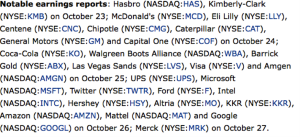
I see a great many trading opportunities in the week ahead as well as a great many opportunities to study the market ever more while parsing through the hyperbole. What is not hyperbole, however, will be the slate of economic data for the week. Below is the table of daily economic data due out this week via MarketWatch:
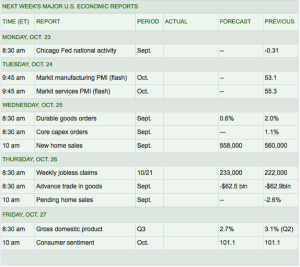
Gross Domestic Product for Q3 2017 will highlight a heavy tech earnings week. Expectations are for the first reading of Q3 GDP to come in at 2.7% according to FactSet data.
As the bull market finds itself “aging or aged” it’s always a beneficial exercise to review one’s risk alongside market valuations. On the surface, the present market valuation has exceeded the historic mean valuation. If we accepted that understanding in a vacuum, we’d likely have been sellers of this market for the majority of 2017, having found ourselves missing out on the continuation of the market rally. The S&P 500 valuation should be better positioned, as it was in the Non-Commercial short positions in VIX futures example, more appropriately for better context. When we review the S&P 500 forward earnings and current yield of 5.51% against that of the 10 year yield of 2.38% there lacks the justification to suggest the markets are overvalued as it is understood investors seek out the greatest yield. And that is before we even introduce core inflation, which is still stubbornly below the 2% Fed target rate. This doesn’t offset the potential for a market correction or even a market shock. Such events are highly unpredictable and is only part of the reason disciplined investors forgo trying to “time” such occurrences in favor of long-term considerations. Here’s to a great trading week ahead and staying liquid my short-VOL friends.
Tags: DIA KLF NASDAQ SPY VIX




